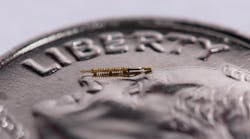This file type includes high resolution graphics and schematics when applicable.
Spring-loaded probe pins have long been a part of electrical and environmental testing, even though they consist of three or four discrete parts and can be laborious (and costly) to assemble into probe assemblies. Also known as “pogo” spring probes, such spring-loaded probe pins provide the compliance to avoid damage to miniature circuits while still providing adequate contact force for sure electrical connections to packages and circuit probe points.
As discrete and integrated circuits (ICs) become more dense in attempts to design more functions into smaller packages, more probe pins are needed for a given probe area. Consequently, high-performance spring-loaded probe pins are often replaced with lower-cost (but lower-performance) stamped contacts.
However, thanks to the development of the H-Pin probe pin by Plastronics, the sacrifice of performance for cost is no longer necessary. The spring-loaded probe pins are suitable both for test applications and board-to-board (BTB) compression connectors.
The H-Pin is a cost-effective, stamped spring probe with outstanding mechanical, electrical, and thermal performance of a spring-loaded probe (Fig. 1). It is a family of products that includes the HO33, HO38, HO57, and HO77 Series H-Pins, with different lengths and pitches to suit the needs of many applications. Models are available with 1-dB bandwidth of wider than 23 GHz, with current capacity of 4 A and wide operating temperature ranges.
All have nominal impedance of 50 ⦠with low capacitance and self-inductance. They employ high-quality materials and trim manufacturing costs through the use of a high-volume beryllium-copper (BeCu) stamping process and high-speed assembly and inspection process. These processes can produce as many as 400 precision pins per minute.
Whether used as contacts for compression connectors or as test probe contacts, these probe pins represent impressive mechanical engineering and manufacturing, given the dimensions (Fig. 2). They can be used in connectors and probes with pitches as fine as 0.2 mm. For example, the HO33 Series H-Pin products feature a minimum pitch of 0.4 mm and a working travel distance (for compression) of 0.4 mm.
Pin contacts in this series are available with lengths from 2.89 to 3.81 mm with a free-air current rating of 1.8 A. They feature 1-dB bandwidth of 10 GHz. The probe pins have less than 50 m⦠contact resistance, with capacitance of 0.067 pF and self-inductance of 0.75 nH. The HO33 Series H-Pins are rated for operating lifetimes of more than 50,000 contacting cycles, with very little change in contact resistance over that time.
At the high-frequency end of the product line, the HO77 Series H-Pins includes probe pins with full lengths from 4.45 to 5.69 mm that can be positioned with minimum pitch of 1.0 mm. They have a working travel distance of 0.7 mm and are rated for mechanical life of better than 125,000 contact cycles. The HP77 probe pins feature contact resistance of less than 16 mâ¦, capacitance of 0.19 pF, and self-inductance of 0.94 nH. They have usable 1-dB bandwidth of 23.3 GHz and offer current-handling capability of 4 A (in free air).
All of the H-Pin spring-loaded probe pins are rated for operating temperatures from −55 to +180°C, although they have been tested at, and performed well at, temperatures well in excess of +200°C. For high-volume testing and for applications involving probing of high-density circuits, the lower cost of these stamped, spring-loaded probe pins compared to conventional spring-loaded probe pins can translate into significant savings, without compromising performance or reliability.
Plastronics, 2601 Texas Dr., Irving, TX 75062; (972) 258-2580
This file type includes high resolution graphics and schematics when applicable.




